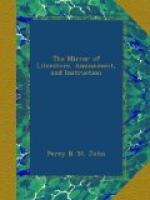Sir Godfrey Kneller latterly painted more for profit than for praise, and is said to have used some whimsical preparations in his colours which made them work fair and smoothly off, but not endure. A friend noticing it to him said, “What do you think posterity will say, Sir Godfrey Kneller, when they see these pictures some years hence?”
“Say!” replied the artist: “Why they’ll say Sir Godfrey Kneller never painted them!”
An extraordinary prosecution for a singular libel occurred under the administration of the Duke of Buckingham. Some fiddlers at Staines were indicted for singing scandalous songs of the Duke. The songs also did not fail to libel both James and Charles. The Bench were puzzled how to proceed. The offensive passages they would not permit to be openly read in court, lest the scandals should spread. It was a difficult point to turn. They were anxious that the people should see that they did not condemn these songs without due examination. They hit upon this expedient. Copies of the songs were furnished to every Lord and Judge present; and the Attorney-General in his charge, when touching on the offending passages, did not, as usual, read them out, but noticed them by only repeating the first and the final lines, and when he had closed they were handed to the fiddlers at the bar, interrogating them whether these were not the songs which they had sung of the Duke? To this they confessed, and were condemned in a heavy fine of 500_l._ and to be pilloried and whipped.
This novel and covert mode of trial excited great discontent among the friends of civil freedom. It was asserted, that all trials should be open, and that a court of justice was always a public place, where the judges publicly delivered the reasons and the grounds of their judgment. The mode now resorted to, was turning a court of judgment into a private chamber, and excluding the hearers from understanding the reasons of every judge’s opinion, and the court themselves from hearing each other’s. It was farther alleged, that in the present case, the Lords could not be sure that the copies showed to the prisoners were the same as that which each had before him, or that every Lord had looked into the same paper which was showed to the fiddlers, so that they might be condemned for that in which they stood not implicated.—I suppose this singular case of the Fiddlers of Staines, to be unique, and never to have been perpetuated in any of our law books.
* * * * *
CHAPEL OF ST. JOHN THE BAPTIST, AT HAMPTON WICK.
[Illustration: CHAPEL OF ST. JOHN THE BAPTIST, AT HAMPTON WICK.]




